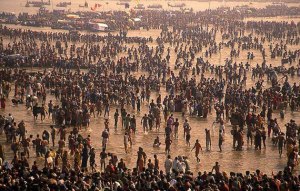 Kumbh Mela is the greatest pilgrimage and festival in the Hindu religion. Derived from Kumbha meaning ‘pitcher’ and Mela meaning ‘festival’, Kumbh Mela is celebrated four times every 12 years, the site of the observance rotating between four pilgrimage places on four sacred rivers: at Haridwar on the Ganges River, at Ujjain on the Kshipra, at Nasik on the Godavari, and at Prayag (Allahabad) at the confluence of the Ganga, Jamuna, and the 'mythical' Saraswati.
Kumbh Mela is the greatest pilgrimage and festival in the Hindu religion. Derived from Kumbha meaning ‘pitcher’ and Mela meaning ‘festival’, Kumbh Mela is celebrated four times every 12 years, the site of the observance rotating between four pilgrimage places on four sacred rivers: at Haridwar on the Ganges River, at Ujjain on the Kshipra, at Nasik on the Godavari, and at Prayag (Allahabad) at the confluence of the Ganga, Jamuna, and the 'mythical' Saraswati.
It is held in twelve year cycles, alternating in such a way that about every three years a Kumbha Mela takes place.
Kumbha Mela has gained international fame as "the world's most massive act of faith". The festival is often regarded as the "biggest religious gathering in the world".
There are five types of Kumbh Melas:
- Maha Kumbh Mela - occurs after 12 'Purna Kumbh Melas' or 144 years – takes place only in Allahabad
- Purna Kumbh Mela - occurs after every 12 years - at Allahabad, Haridwar, Ujjain, and Nashik
- Ardh Kumbh Mela - celebrated every six years - at Haridwar and Allahabad
- Kumbh Mela - celebrated every 3rd year - rotating between Prayag, Nasik, Haridwar and Ujjain
- Magh Mela - annual, held every year except years of Kumbh Mela and Ardh Kumbh Mela - only in Allahabad
Kumbh Mela is celebrated at different locations depending on the position of the planet of Bṛihaspati (Jupiter) and the Sun (more on this a later post).
Famous ancient traveller, Huen Tsang of China, was the first to mention Kumbha Mela in his diary. His diary mentions the celebration of 75 days of Hindu month of Magha (January-February), which witnessed half a million devotee including sadhus, common man, rich & famous & kings.
The great Indian saint Shankara, who lived in the 8th century CE, is credited with popularizing the Kumbh Mela among the common people.
Renowned American author Mark Twain was so mesmerised after visiting the Kumbh Mela of 1895 that he wrote:
“It is wonderful, the power of a faith like that, that can make multitudes upon multitudes of the old and weak and the young and frail enter without hesitation or complaint upon such incredible journeys and endure the resultant miseries without repining. It is done in love, or it is done in fear; I do not know which it is. No matter what the impulse is, the act born of it is beyond imagination, marvelous to our kind of people, the cold whites.”
Snana Parva or bathing in the river is one of the most important part of the Kumbh Mela (detailed post on this later). It is believed that it washes away all the sins and the cycle of rebirth and death ends as the soul becomes one with God Almighty.
Starting today we will one by one unravel all the aspects associated with Kumbh Mela.
No comments:
Post a Comment